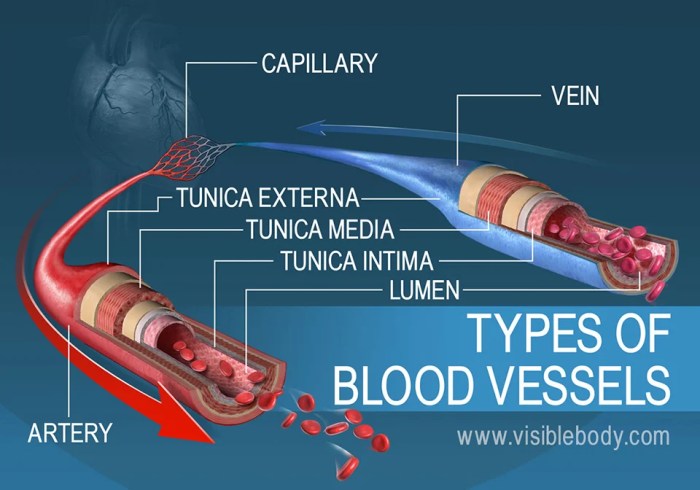Blood vessels, the intricate network that courses through our bodies, play a vital role in maintaining homeostasis and supporting life. This article delves into the fascinating world of blood vessels, exploring their diverse types, intricate structure, and essential functions, shedding light on the statement: “Which statement is true regarding blood vessels?”
Blood vessels, comprising arteries, veins, and capillaries, exhibit distinct characteristics and functions. Arteries, responsible for carrying oxygenated blood away from the heart, possess thick, muscular walls to withstand high blood pressure. Veins, on the other hand, transport deoxygenated blood back to the heart and have thinner walls and valves to prevent backflow.
Capillaries, the smallest and most numerous type, facilitate the exchange of nutrients and waste products between blood and tissues.
Overview of Blood Vessels: Which Statement Is True Regarding Blood Vessels

Blood vessels are a network of tubes that carry blood throughout the body. They are classified into three main types: arteries, veins, and capillaries. Each type of blood vessel has a specific structure and function.
| Type | Structure | Function | Flow |
|---|---|---|---|
| Artery | Thick, muscular walls | Carry oxygenated blood away from the heart | High pressure, high velocity |
| Vein | Thin, less muscular walls | Carry deoxygenated blood back to the heart | Low pressure, low velocity |
| Capillary | Microscopic, thin walls | Allow for exchange of gases and nutrients between blood and tissues | Low pressure, slow velocity |
Structure and Function of Blood Vessels

Arteries
Arteries have thick, muscular walls that allow them to withstand the high pressure of blood pumped from the heart. They branch out into smaller arteries and arterioles, which deliver blood to capillaries.
Veins, Which statement is true regarding blood vessels
Veins have thin, less muscular walls than arteries. They collect blood from capillaries and return it to the heart. Veins have valves that prevent blood from flowing backward.
Capillaries
Capillaries are the smallest blood vessels. They have thin walls that allow for the exchange of gases and nutrients between blood and tissues. Capillaries are found in all tissues of the body.
Flow of Blood through Blood Vessels
Blood flows through blood vessels in a specific direction. Oxygenated blood is pumped from the heart through arteries. Arteries branch into arterioles, which then branch into capillaries. Capillaries allow for the exchange of gases and nutrients between blood and tissues.
Deoxygenated blood is collected from capillaries by venules, which then join together to form veins. Veins return deoxygenated blood to the heart.
Regulation of Blood Flow

Blood flow through blood vessels is regulated by a number of mechanisms, including the autonomic nervous system and hormones. The autonomic nervous system can constrict or dilate blood vessels, which changes the amount of blood flow to different parts of the body.
Hormones can also affect blood flow. For example, adrenaline can cause blood vessels to constrict, which increases blood pressure.
Blood Vessel Disorders
There are a number of common blood vessel disorders, including:
- Atherosclerosis: A condition in which plaque builds up in the arteries, narrowing them and restricting blood flow.
- Thrombosis: A condition in which a blood clot forms in a blood vessel, blocking blood flow.
- Embolism: A condition in which a blood clot or other material travels through the bloodstream and blocks a blood vessel.
- Hypertension: A condition in which blood pressure is abnormally high.
- Hypotension: A condition in which blood pressure is abnormally low.
Expert Answers
What is the primary function of arteries?
Arteries carry oxygenated blood away from the heart to tissues and organs.
How do veins differ from arteries?
Veins have thinner walls and valves to prevent backflow of blood, and they transport deoxygenated blood back to the heart.
What is the role of capillaries in the circulatory system?
Capillaries facilitate the exchange of nutrients, oxygen, and waste products between blood and tissues.